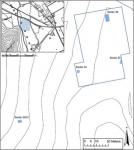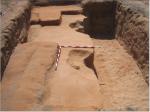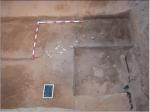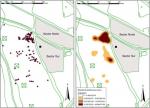Summary (English)
The first archaeological excavation at this site was conducted in 2006. The results of that fieldwork revealed the existence at least of two stages of occupation:
- one Preceramic phase which the characterization of recovered the lithic industry provisionally placed in the Epipaleolithic of Notches and Denticulates and
- one Ceramic phase, corresponding to the Early Cardial and Epicardial Neolithic, which is identified through the review of the materials deposited in the Museo Municipal de Villena.
On this first level of knowledge the realization of a new excavation campaign had been raised in 2007. The main objectives were to determine the role and absolute chronology of the archaeological levels and structures documented in the archaeological excavation in 2006 of Polls 1 and 6. To detect possible archaeological structures in the subsurface geophysical prospecting was developed with Ground Penetrating Radar (GPR). The GPR work was conducted in the area of settlement which presented higher density of surface finds. Their results were then contrasted archaeologically by conducting sixteen coil polls and two manual surveys. All generated data have been introduced into a Geographical Information System (GIS) used as a platform for management and spatial analysis. As a result of the data processing a close spatial correlation has been detected between the area that concentrates the highest densities of findings and the southern sector of J. M. Soler’s collections.
One of the most important tasks developed in the 2007 campaign involved the manual excavation of the documented evidences of Surveys 1 and 6 in 2006. In this way we have been able to define the morphology, characteristics and the extent of the two underground structures previously documented at the profile of the trench. Both have irregular morphology (cuvettes 1 and 2) and are covered by a level (Level I) with archaeological material that could correspond to a moment of occupation or neglect. At present it is not possible to completely clarify its functionality even though we propose several uses: as a support for a container, a sand mining pole or base for constructive purposes. From the fill of hole 1 a piece of coal (identified as Pinus sp.) was dated by C14 AMS which refers to the XIIth-XIIIth centuries; this dating is clearly at variance with other material remains found in the same sector, such as carved stone industry from the level which covers the cuvettes.
For its part, the intervention developed in Sector 30/37 affected a total area of five square meters adjacent to the area where lithic and malacological remains were found in addition to the stones which were burned in 2006. In addition to the establishing of the already known archaeological stratigraphy, the number of findings increased and a combustion structure has been documented which corresponds to a partially unstructured hearth. In clear spatial connection with this hearth a secondary grouping of fractured rocks has been registered. They are limestone clasts of 3/8 centimetres in length and they are completely burned; they exhibit thermal fractures and colour changes towards dark grey tones. This type of alteration is indicative of thermal thresholds near 700 degrees centigrade. The radiocarbon dating has confirmed the diagnosis derived from the technological and typological analysis of the carved stone industry recovered in 2006 and 2007; everything seems to indicate its attribution to the so called Macrolithic Epipaleolithic or Epipaleolithic of Notches and Denticulates
In short, the works carried out have documented two phases of occupation at the site: a ceramic phase, with a relative chronology of the Early Cardial and Epicardial Neolithic, currently only recognised by the analysis of the ceramic materials from the J.M. Soler collection; and one Preceramic phase, corresponding to Epipaleolithic of Notches and Denticulates, presenting a partially dismantled fireplace, lithic and malacological remains. This gives a unique character to the Arenal de la Virgen which thus constitutes the only site of de Mesolithic of Notches and Denticulates with habitat structures in a lacustrine environment of the Iberian Peninsula.
(translation by Pilar Alarcón Blázquez)
- Javier Fernández López de Pablo y Magdalena Gómez Puche
Director
- Javier Fernández López de Pablo (Department of Anthropology, University of California)
- Magdalena Gómez Puche (Departamento de Prehistoria, Universidad de Valencia)
Team
- Agustín Diez Castillo (Dpto. de Prehistoria, Universidad de Valencia) y Begoña Soler (Servicio de Investigación Prehistórica)
- Francisco García García (Dpto. de Ingeniería Cartográfica), Isabel Rodríguez Abad (Dpto. de Construcción Arquitectónica), Rosa Martínez (Dpto. de Física Aplicada)
- Museo Arqueológico “José María Soler” de Villena
- Yolanda Carrión Marco (Dpto. Prehistoria y Arqueología, Universidad de Valencia)
- Carlos Ferrer García (Servicio de Investigación Prehistórica)
- Alberto Martínez Ortí (Museo Valenciano de Historia Natural)
Research Body
- Colegio Oficial de Doctores y Licenciados en Filosofía y Letras y en Ciencias de Alicante - Sección de Arqueología
- Universidad de Valencia
- University of California
Funding Body
- Departamento de Prehistoria, Universidad de Valencia
- Department of Anthropology, University of California






![Download [PDF]](/excavation/skins/fasti/images/results/download_sml.png)


